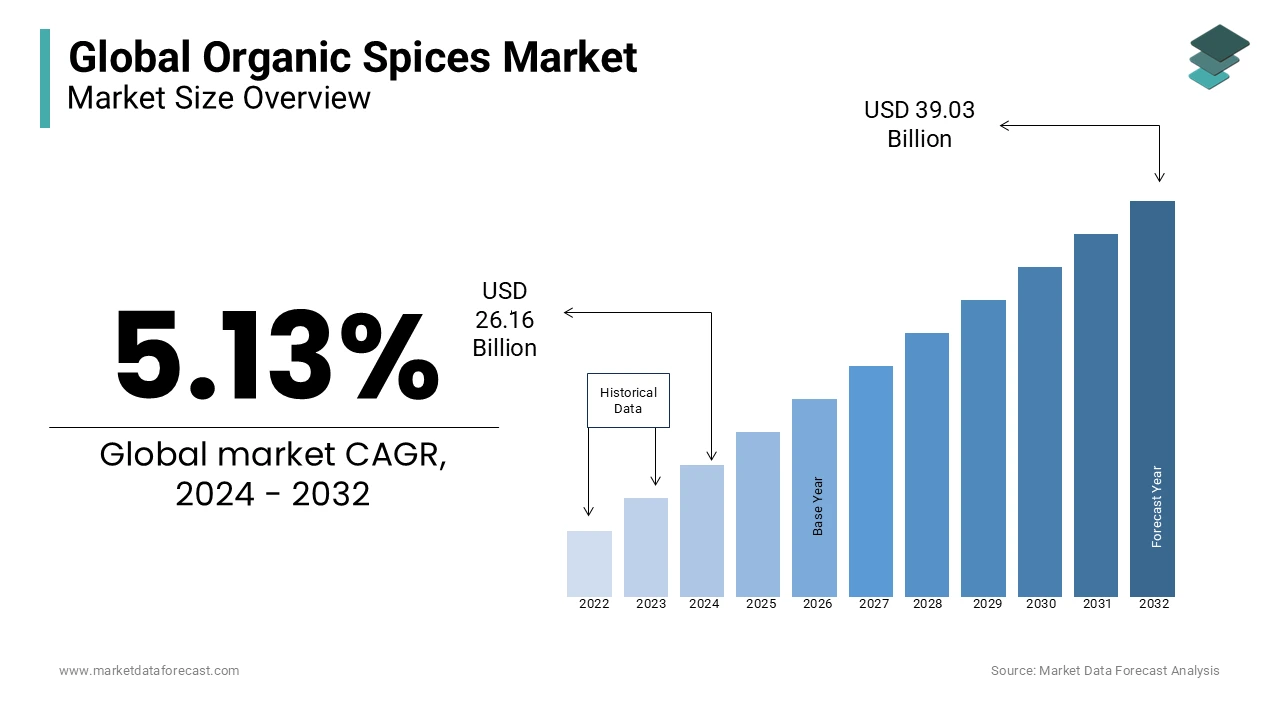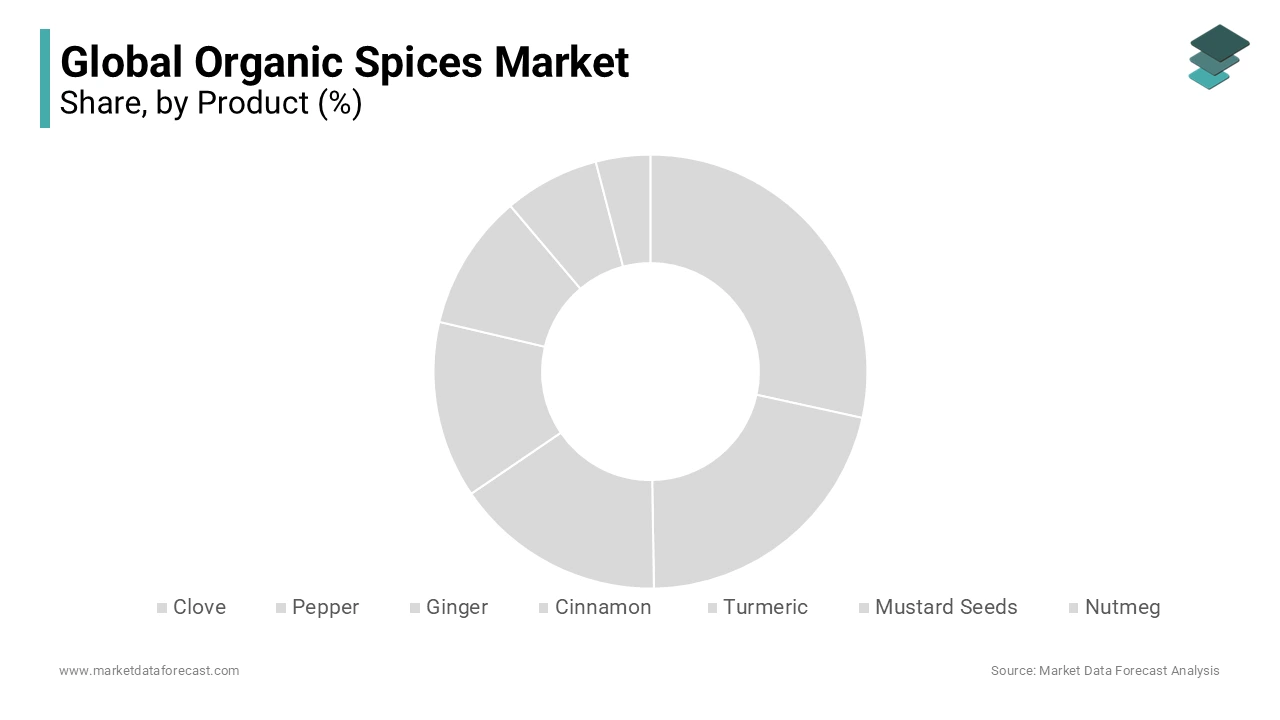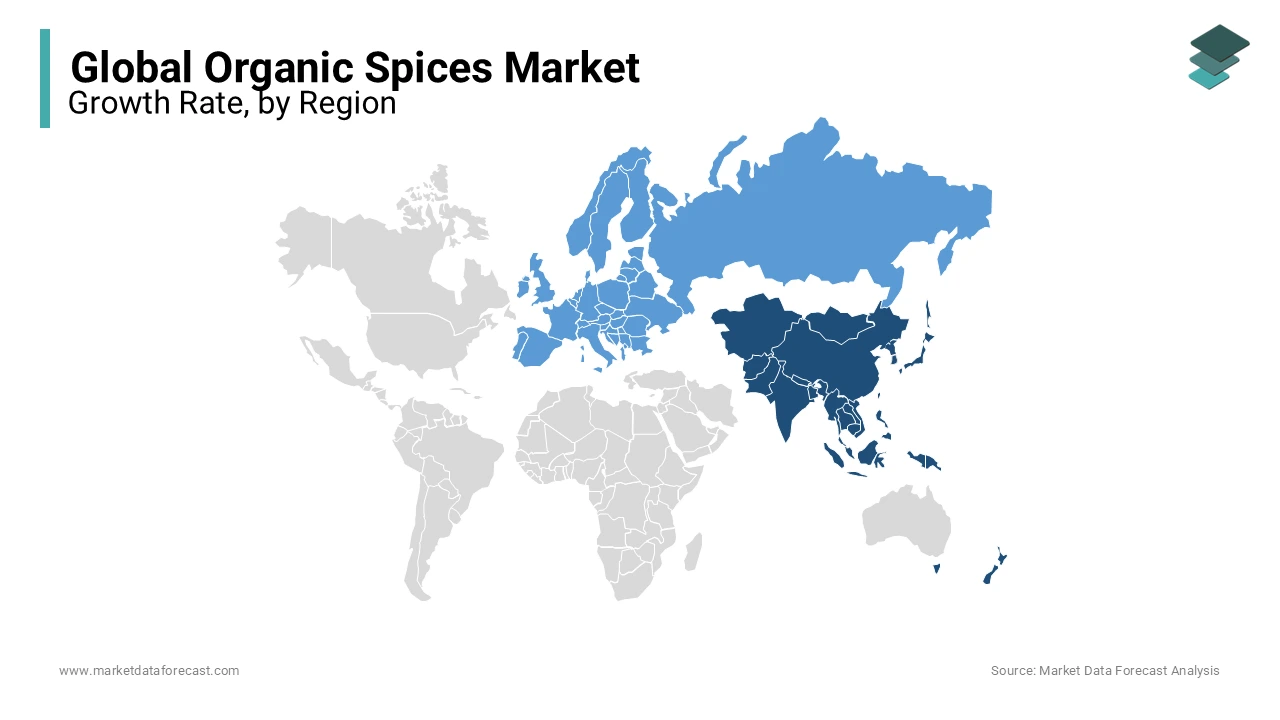Global Organic Spices Market Size, Share, Trends & Growth Forecast Report – Segmented By Product (Clove, Pepper, Ginger, Cinnamon, Turmeric, Mustard Seeds and Nutmeg), Form, Distribution Channel, and Region (North America, Europe, Asia Pacific, Latin America, Middle East and Africa) - Industry Analysis (2024 to 2032)
Global Organic Spices Market Size
The global organic spices market size was valued at USD 26.13 billion in 2024, and the global market size is expected to reach USD 40.99 billion by 2033 from USD 27.47 billion in 2025. The market's promising CAGR for the predicted period is 5.13%.

Organic spices use new techniques and remove spices from bacteria to avoid harmful pesticides. It is a combination of healthy and safe foods because organic spices guarantee safety. Organic spices like turmeric, ginger, cloves, and cinnamon also have a variety of health benefits. The antioxidant properties of turmeric and ginger help fight Alzheimer's, cancer, and many other viral illnesses. The antibacterial properties of cloves and cinnamon help treat viral diseases and sore throats. Various types of spices that are frequently used include garlic, turmeric, coriander, chili powder, ginger, nutmeg, and mace.
Current Scenario
Presently, the demand for organic spires is high considering the recent finding of cancer-causing ingredients in popular brands. There is an increasing customer preference for natural food products which is propelled by rising health awareness and understanding of advantages related to it. Moreover, several government regulations and policies are compelling cultivators to adopt organic farming methods by giving subsidies and incentives. Additionally, the rising consumer readiness to pay a premium amount for organic items, due to the expanding expenditure abilities, is adding to the market growth.
MARKET DRIVERS
The rise in demand for organic spices in the food and beverage sector is majorly fuelling the growth of the global market. The demand for organically grown spices is expected to increase as awareness of the harmful effects of chemicals, pesticides, and additives increases. Other factors, such as changing food consumption trends and the popularity of ethnic and exotic foods, are supposed to drive growth. In addition to innovating new flavors in the prepared foods sector, increased consumption of prepared foods such as soups, snacks, and frozen and baked goods is assumed to boost product demand. The popularity of multi-cuisine and international dishes is likely a significant factor driving demand for organic spices. Demand for flavors in powder form is expected to accelerate as customer preference for ready-to-use flavors increases to save time during cooking without compromising taste.
The rising preference for full-flavored products incorporating ethnic ingredients is contributing to the growth of the organic spices market. Preferences for chemical-free and healthy products are expected to increase, and the high demand for traditional and exotic ethnic food flavors is anticipated to drive growth. In addition, the introduction of authentic spices from top brands is estimated to have a positive impact on global demand. An increase in the number of health-conscious consumers and increasing awareness of the health benefits of consuming organic flavors are two key factors driving the growth of the global organic food and beverage sector.
The rising demand and increasing consumption of organic food worldwide are boosting the market for organic spices. North America and Europe are notable regions in terms of the consumption of various types of organic food due to the increase in per capita income in the area and the continuous evolution of the product by the manufacturer. Additionally, some food manufacturers strongly prefer organic products and have focused on providing food organically. Spices have gradually resisted the trend organically. They are available in different forms depending on consumer preferences, i.e., powders, granules, and liquids, which are expected to promote market growth further. Increased awareness of the health benefits of naturally produced spices due to their therapeutic properties will stimulate demand for products during the outlook period. Spices are mainly used for flavoring, preserving, and coloring food. The most commonly used organic ingredients are turmeric, chili, ginger, garlic, coriander, nutmeg, and mace. The individual solid flavor and food-enriching scent for various food applications remain crucial drivers of demand. Due to the long-lasting aromatic properties, the popularity of exotic natural ingredients in food preparations has a positive effect on the growth of the organic spice market. Spices are essential in various cuisines worldwide due to their decorative and flavoring benefits. These ingredients add a balanced amount to each dish, providing a pleasant aroma and enriching the quality of the food.
MARKET RESTRAINTS
High price margins in importing countries and various trade regulations are deemed to hamper the organic spice market growth worldwide. High production and logistics costs result in a higher price range for organic spices than traditional spices. Withdrawal among farmers who convert conventional farming methods to organic farming and slow production in some regions may hinder market growth.
The high costs associated with premium organic food products, which are challenging for many people to afford, hamper the market growth. Additionally, organic farming often results in lower yields than conventional methods, which limits market revenue and restricts farming practices among farmers. Stringent regulations and rigorous certification processes are prominent global challenges to the organic spices market. Achieving and maintaining organic certification requires adherence to strict guidelines, including soil management, pest control, and record-keeping, which will hinder the market growth opportunities.
MARKET CHALLENGES
The supply of unsafe ingredients and the circulation of misleading food advertisements because of regulatory gaps. It is a major concern since it directly affects the well-being of a large population in all major spice-importing countries. Likewise, the existing Food and Drugs Administration (FDA) procedures enable the food industry to govern itself about thousands of added ingredients by identifying for itself which elements should be regarded as GRAS or “generally recognized as safe”. It also makes decisions on its own about whether or not to reveal the component's application and the fundamental safety information to the FDA. Consequently, several new materials have been included in the food supply without any state control. Hence, it’s a major challenge for the market growth.
MARKET OPPORTUNITIES
There is huge growth potential for the organic spices market by integrating data analytics and artificial intelligence (AI). The companies in this market are commencing to utilize modern technology for predicting demand accurately. Previously, market players experienced significant wastage and loss due to inaccurate estimation. So, AI with data gathering and analysis tools are believed to reshape the market. In addition, it will benefit in streamlining the supply chain. AI can track and determine any delays in shipments and recommend alternate transportation routes if required. Additionally, in the coming years, various legal amendments or new regulations to stop fake and misinformation on the label. Apart from this, the market is projected to advance with the acceptance of sustainable farming and packaging in the industry.
REPORT COVERAGE
|
REPORT METRIC |
DETAILS |
|
Market Size Available |
2024 to 2033 |
|
Base Year |
2024 |
|
Forecast Period |
2025 to 2033 |
|
CAGR |
5.13% |
|
Segments Covered |
By Product, Form, Distribution Channel, And Region |
|
Various Analyses Covered |
Global, Regional and Country Level Analysis; Segment-Level Analysis; DROC; PESTLE Analysis; Porter’s Five Forces Analysis; Competitive Landscape; Analyst Overview of Investment Opportunities |
|
Regions Covered |
North America, Europe, APAC, Latin America, Middle East & Africa |
|
Market Leaders Profiled |
UK Blending LTD, Organic Spices Inc, Daarnhouwer & Co, Spice Chain Corporation, The Watkins Co, Sabater Spices, Pacific Spice Company, Inc, Husarich GmbH, AKO GmbH, SunOpta Inc |
SEGMENTAL ANALYSIS
By Product Insights
Turmeric is the most in-demand segment in the organic spices market owing to its rising awareness about its health benefits. The majority of people consume it for its antioxidant and anti-inflammatory qualities which is the primary reason behind its growing market share. This resulted in higher customer inclination towards turmeric as a culinary ingredient and dietary supplement. As per a 2025 study, worldwide it is mainly utilized as a fundamental cooking spice in the South and a well-known herbal treatment in the North. In Asian countries, apart from being traditionally used as medicine, it is extensively known as a food flavoring and coloring condiment. Furthermore, the market witnessed turmeric has been integrated into Western cosmetic and medical customs, of which the United States is no exception.

By Form Insights
The powder segment is the leading category of the organic spices market and is followed by the granular segment. The powder segment’s growth can be attributed to its properties which make it ready to cook, time-efficient, and easy to use. Comfort is one of the key elements fuelling the escalating demand for power-based spices. Moreover, they can be simply added to a wide range of food and beverage recipes, so it is estimated to propel sales of this segment and ultimately market share throughout the forecast period. Besides these, today’s busy lifestyles and the availability of online grocery and delivery platforms have further boosted sales in this segment.
By Distribution Channel Insights
The indirect segment gained the maximum share of the organic spices market. This includes convenience shops, speciality stores, supermarkets and hypermarkets. Presently, supermarkets and hypermarkets have captured a notable market share in the Tire 1 and Tire 2 cities. In addition, Retail giants have an extensive presence in several regions and provide a varied range of items, including organic spices. This accessibility makes it simpler for customers to find the particular spices they're searching for without the need to visit different speciality shops. Furthermore, supermarkets/hypermarkets have significant financial budgets for marketing and promotion of organic goods, including spices.
REGIONAL ANALYSIS
Asia-Pacific is the most lucrative regional segment for organic spices worldwide and the growth of the APAC market is majorly driven by changing food trends. Increased consumption of flavored and ethnic organic spices influenced by the existence of large multi-cultural groups in evolving economies countries such as China. Growth is expected to be witnessed due to usage in India. Also, the introduction of new and exotic flavors is anticipated to increase consumer disposable income, and the acceptance of innovative characters is even foreseen to drive local demand. Asia-Pacific also has a significant share of the global organic flavor market, with substantial production of natural flavors in the region. Furthermore, the growing awareness of organic spices and the high consumption of spices in local cuisine is accelerating the growth of the market.

The European market expects a significant increase in spice consumption, especially in Sweden and the UK, with an annual compound rate of over 5.5% over the forecast period. As the preference for natural foods increases, consuming ethical foods will support industrial demand. The European organic spices market is assumed to grow as European countries' preference for multicultural cuisine increases. The expansion of the conventional retail industry, including supermarket chains, will boost local demand. North America is expected to dominate the world with an organic spice market during the projection period. The United States is suspected to be a significant contributor to the organic spice market in the region. The high demand for organic and natural food ingredients in the US population is primarily driving the growth of the North American organic spices market.
KEY PLAYERS IN THE ORGANIC SPICES MARKET
Global Key Players in the organic spice market are UK Blending LTD, Organic Spices Inc., Daarnhouwer & Co, Spice Chain Corporation, The Watkins Co., Sabater Spices, Pacific Spice Company, Inc., Husarich GmbH, AKO GmbH, SunOpta Inc. are some of the notable companies in the global organic spices market.
RECENT HAPPENINGS IN THE MARKET
- In July 2025, Frontier Co-op introduced the first nationally available Regenerative Organic Certified bottled spices to assist small-scale farmers and provide customers with culinary choices which are socially, ethically and environmentally friendly at all levels. This new Regenerative Organic Certified range will be present in select shops commencing from October 2025.
- In April 2025, the Kraft Heinz Company reported the entry of Just Spices into the United States market. Just a year ago the company completed its purchase of a controlling stake in the business. Moreover, this launch in the US market is to boost its portfolio of taste elevation.
MARKET SEGMENTATION
This research report on the global organic spices market has been segmented and sub-segmented based on product, form & region.
By Product
- Clove
- Pepper
- Ginger
- Cinnamon
- Turmeric
- Mustard Seeds
- Nutmeg
By Form
- Powder
- Extract
- Raw
- Granular
By Distributional Channel
- Direct
- Indirect
By Region
- North America
- Europe
- Asia Pacific
- Latin America
- Middle East and Africa
Frequently Asked Questions
1. What is the CAGR of the Global Organic Spices Market from 2025 to 2033?
The Global Organic Spices market is expected to grow at a CAGR of 5.13% during the forecast period 2025 to 2033.
2.Are organic spices more expensive than conventional spices?
Yogi Botanicals Pvt Ltd.; Live Organics; Starwest Macroeconomics; Rocky Mountain Company; Salzhäusl Himalaya-Kristallsalz GmbH; Rapid Organic pvt. The Spice Hunter Inc.; Earthen Delight; Frontier Natural Products Corporation; and The Spice Hunter. Ltd
3.How can I identify organic spices?
Look for certification labels such as USDA Organic (in the United States), EU Organic (in the European Union), or other recognized organic certifications specific to your region. These labels indicate that the product has been verified to meet organic standards.
Related Reports
Access the study in MULTIPLE FORMATS
Purchase options starting from $ 2500
Didn’t find what you’re looking for?
TALK TO OUR ANALYST TEAM
Need something within your budget?
NO WORRIES! WE GOT YOU COVERED!
Call us on: +1 888 702 9696 (U.S Toll Free)
Write to us: [email protected]